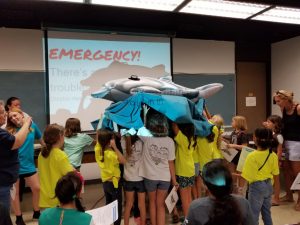Fall 2018 – Education Spotlight
– JANUARY 8, 2019
(From Fall 2018 Newsletter)
Members of the Consortium for Advanced Research on Marine Mammal Health Assessment (CARMMHA), including Mandy Tumlin, Jaimie Thompson, Ashley Barratclough, Alissa Deming, Brittany Novick, and Celeste Parry, participated in the Girl Scouts Believe in G.I.R.L. (Go-Getter, Innovator, Risk-Taker, Leader; B.I.G.) event, hosted by the Girl Scouts Louisiana East Council at the University of New Orleans in New Orleans, Louisiana on September 29, 2018. The event featured more than 40 displays and demonstrations highlighting STEM opportunities for girls, as well as life skills, entrepreneurship, the outdoors, arts, and more geared towards girls of all ages, from kindergarten through high school. The United States Coast Guard, the Louisiana State University Museum of Natural Science, the Association for Women and Science, and many others organizations participated. The CARMMHA team hosted several workshops during the event that included information about marine mammals and simulated performing health assessments on them. Check out the CARMMHA Facebook page for more information here. To learn more about the Girl Scouts Louisiana East Council and the B.I.G. event, visit their website.
Members of the Consortium for Oil Spill Exposure Pathways in Coastal River-Dominated Ecosystems (CONCORDE), including Inia Soto (now with the Gulf of Mexico Research Initiative Information and Data Cooperative (GRIIDC) at Texas A&M University – Corpus Christi), Kemal Cambazoglu, Jessie Kastler, Sabrina Parra, and Bob Arnone, published an article in the November 2018 issue of the National Science Teachers Association journal The Science Teacher called Virtual Oceanography: Studying river plumes using data visualization tools, ocean model data, and satellite imagery. The article features a classroom activity geared toward high school students, focused on using satellite-derived chlorophyll-a imagery and model-derived salinity data to construct a virtual cruise, including determining the scientific objectives, charting the cruise track under a specified budget and time frame, drawing scientific conclusions based on the data provided and the selected cruise track, and writing a cruise report. The activity also includes opportunities for students to learn about and utilize ArcGIS Earth to chart their cruise path and analyze mapped geographic information. The overall goal of the activity is to encourage students to engage in active learning by challenging them to think through all the steps involved in the scientific process, from determining the research plan, to collecting data, to analyzing the results. John Dupuis, who attended a CONCORDE teacher workshop during the AUV Jubilee, piloted the activity with 80 environmental science students at St. Thomas More High School in Lafayette, Louisiana. The journal is offering this article as a free download, which can be accessed by signing up for a free account with the National Science Teachers Association here.







